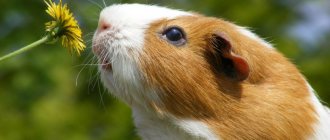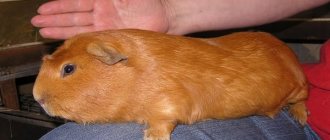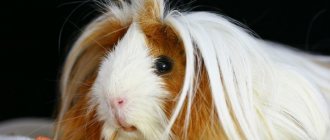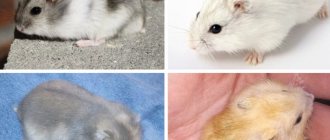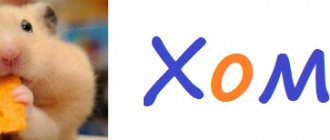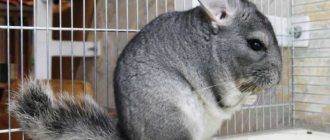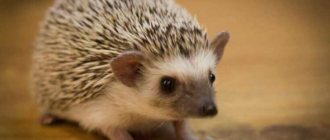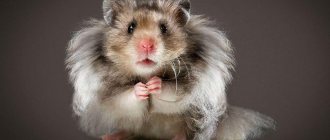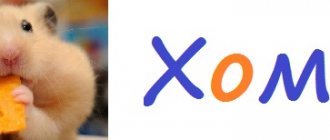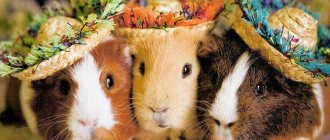- home
- Guinea pig
- Guinea pig breeds
02/19/2019 Long-haired guinea pigs are popular as pets due to their beautiful, silky coat. They have special needs regarding grooming. If these needs are ignored, pets will lose their healthy and beautiful appearance and will begin to get sick. Studying detailed information about keeping and caring for the animal will help the owner take proper care of it.
Description and appearance
The long-haired guinea pig was bred for decorative purposes: for home keeping and participation in competitions and exhibitions. All wild ancestors of the animal have short hair.
The body of a long-haired pig is the same in parameters as other varieties: oval body, short neck, rounded muzzle. The ears are “envelope-shaped” - slightly drooping. The paws are short, with 4 toes on the front and 3 on the hind. The length of the body and weight vary from breed to breed, but on average they are 25-35 cm and 1-1.2 kg.
The pet's coat grows up to 50 cm. There are both solid colors and multi-colored ones. The most common color is red in different shades. The rarest is tortoiseshell. Exclusive colors are obtained after crossing a large number of animals (100 or more individuals) belonging to the same breed.
Among the long-haired pigs there are pigs with straight, curly, wavy strands. The presence and location of rosettes, partings, direction of hair growth, etc. vary.
Lifespan
Depending on the conditions of detention, pigs live on average about 5 years. Under favorable conditions, an age of 7-8 years is possible. If a healthy pedigree is added to this, the pet will live up to 10 years.
Purchase rules
You can buy a real Peruvian guinea pig as a pet only in specialized nurseries. Otherwise, you may fall for a “fake”. This will not make the animal worse or more beautiful, but it will still be a shame for the money spent.
Before the transaction, they check the presence of all documents, find out about the animal’s parents and make sure of the noble origin of the rodent. At the same time, they agree with the owners of the nursery about the opportunity to consult if necessary. Usually employees agree to this with joy, since they, too, are not indifferent to the fate of the “child.”
Keeping and caring for a long-haired guinea pig
Pigs have a calm and friendly character, but it is better not to have them in a family where there are preschool children: children do not always calculate their strength correctly and are capable of accidentally causing harm to the pet. But for children of primary and secondary school age, pets are quite suitable. You should also carefully introduce the rodent to dogs, cats and other pets. Depending on each pet's personality, they may be reluctant to get along with each other. Guinea pigs are often purchased in pairs (of the same or different sexes) so that they do not get bored in the absence of the owner. They get along well with each other.
Buy a cage that is spacious and roomy. The appropriate size for one pig is 60x40x60 cm. The home is located away from windows, balconies, radiators and doors to avoid drafts and direct sunlight. Pets are sensitive to temperature changes: it should be kept in the range of 18-22 degrees.
These rodents are easily injured when falling, so the cage should be one-story or include one additional low floor. Required equipment for the cage:
- Bowl;
- drinker (preferably ball);
- feeder or manger for hay and grass;
- toilet tray;
- mineral stones or twigs for grinding teeth;
- house (placed on the lower tier).
The floor of the cage is sprinkled with sawdust or filler. If the pet is litter box trained, it is enough to change the bedding once a week, and if not, 2-3 times. In addition, bowls and drinking bowls must be washed daily.
It is not recommended to keep your pet in a cage all the time. At least several times a week, he is allowed to run around the floor, having previously removed dangerous or necessary things from the access area: wires, books, indoor plants, clothes.
Himalayan
The Himalayan albino pig has a unique genetic coat color: a snow-white shade with a dark characteristic spot in the nose area. Another amazing feature: the absence of eye pigment, which makes the pupils appear red, although in fact only the blood vessels that create such an unusual color are visible. The ears have an unusual petal-shaped shape. The hair is hard, dense and thick. As the air temperature decreases, its tone changes somewhat towards a darker side. These rodents are afraid of sunlight, so when choosing a place for the cage, take this feature into account. They have a calm, balanced character, making them great for families with small children.
Himalayan
Feeding
Pigs eat plant foods. Their diet contains both dry food and succulent food. There should be more of the latter, but not too much, otherwise it will lead to diarrhea. Juicy foods include grass, greens, and vegetables. Sometimes fruits or berries are offered in small quantities as a treat. A variety of vegetables are offered. A large amount of one product will lead to negative results. For example, too much white cabbage will cause flatulence in your pig. Feeding is carried out at the same time, because The animal’s gastrointestinal tract needs regular portions of new food, which “moves” the previous one through the intestines. The pet may die if it does not receive food within 18 hours.
Pigs, like other rodents, periodically eat their own excrement. This is due to the fact that vitamins K and B remain in the primary, soft feces, which are necessary for maintaining health. Therefore, it is better not to purchase a cage with a special tray. This is convenient in terms of hygiene - long hair gets dirty less, but then the pet will not be able to take doses of natural vitamins and will have to buy them additionally at the pharmacy.
The pig's water is changed every day. Use filtered or boiled at room temperature. Cold water leads to colds or pneumonia. On average, a pet drinks up to 80 ml of water per day. If your pig drinks little, most likely she needs enough fluid from succulent food.
Hygiene and grooming
Owners of long-haired pigs pay a lot of attention to hair care. Your pet should be brushed daily with a soft brush. This prevents the formation of mats and some skin parasites. During combing, the hairs are saturated with oxygen, which makes the fur look shiny and well-groomed. In addition, the process of combing calms the pet and brings him pleasure.
It is better to cut off the resulting tangles, because... unraveling will cause unnecessary anxiety for both the owner and the animal. Many pigs do not like water treatments. If the pet gets dirty, do not bathe it, but carefully wash the stained area, then dry it with a towel and then with a hairdryer at low power.
If there is no need or desire to leave long hair, it can be trimmed regularly, especially in the summer - this will keep the pet cooler and more comfortable. Or at least trim the bangs above the eyes so that the pig can see better and not spoil his vision. Wearers who like long locks use small elastic bands, clips or curling irons to hold their hair together, avoiding tangles and messes. In addition, this makes it easier for the animals to move around.
In addition to the fur, it is necessary to take care of your pet’s claws and ears. Growing claws are regularly trimmed with scissors or a special nail clipper. The ears are cleaned with cotton swabs, first lightly moistened in vegetable oil - to prevent infections.
Features of agouti
The agouti guinea pig is an amazingly beautiful guinea pig, which is loved all over the world for its beautiful smooth coat of amazing color, good-natured character and high intellectual abilities.
The most important feature of these pigs is their unusual coat color, the so-called ticking, when each hair is colored in a special way: closer to the skin, the hair has a primary color, in the central part it becomes lighter, and at the tip it darkens again. This is the most common option. In general, there are three types of ticking:
- dark – basic – dark colors again;
- dark and primary colors:
- dark color without a light part.
The color of the fur on the belly corresponds to the color of one part of the hairs of the coat and contrasts with the general tone of the pig, speckling is excluded. Agouti pigs have dark eyes. Large, delicate ears that hang down and are shaped like petals.
As a rule, these pigs have a strong and strong physique. They have strong, short legs.
Pet health
The animals have strong immunity, so infectious diseases rarely bother them. They usually appear if the pet often walks outside or if one of the household, including other animals, gets sick. Common infectious diseases include:
- skin infections;
- salmonellosis;
- toxoplasmosis;
- ringworm;
- coccidiosis.
In addition, a pet can be harmed by physical injury or a violation of the diet: spoiled or poisonous foods, intolerance (allergy) to some component. In this case, cystitis, conjunctivitis, and neoplasms are possible. Foods prohibited for pigs include:
- dairy products;
- products of animal origin;
- sweets;
- flour;
- cooked food from the common table.
The first sign that your pet is feeling unwell is a decrease in appetite or refusal to eat. In such cases, you should find out the reason for this behavior as soon as possible and take action. Prolonged hunger strikes lead to exhaustion of the body and worsening of the disease.
Where does skinny live?
Photo: Skinny at home
These adorable looking hairless pigs can never be found in the wild because they are the result of experiments carried out in a laboratory. These cute little creatures are actually genetic mutations that were first created in 1978 in the laboratories of the Armand Frappier Institute, which is located in Montreal, Canada.
Since skinnies do not have fur, they should be kept indoors in a warm environment. Because they don't have fur, which naturally keeps them warm in cold weather, skinnies get colds or even hypothermia very easily. You need to make sure that they live in an area that is comfortable and warm so that they never feel cold.
During the hot summer months, you have to be careful not to let your skinny skin tan. So if you take them outside, you'll need to make sure you apply some sunscreen to their body and face, and be especially careful not to get it on your pet's eyes.
Being such funny, inquisitive little creatures and so friendly, skinnies are making their mark on the animal kingdom thanks to their owners who have now settled in many parts of the country. Because skinnies must live indoors, they truly become part of the family, much like a cat or dog. Since there is no fur on their body, every little detail about them is highlighted, and this includes any markings where fur would grow. However, Skinnies do have some hair on their nose and paws, but other than these areas they are completely hairless from birth.
Reproduction
Pigs reach sexual maturity at 2-3 months. At this age they are able to reproduce. Repeated mating is possible just a day after the last birth. But from a health point of view, such sexual activity does not lead to positive consequences. Early pregnancy in pets causes complications and health problems in females. Therefore, it is recommended to arrange the first birth no earlier than 5-6 months of life. In addition, it is recommended to arrange pregnancy no more than twice a year. And in males, frequent sexual intercourse leads to infertility.
Parents must not be closely related. This circumstance increases the risk of genetic diseases in offspring. For the purity of the breed, it is better if the adult pigs belong to the same species and are the same age.
During the first birth, the female often gives birth to only one large cub. The average number of fruits is 2-4, medium in size. Pregnancy lasts 10 weeks. Small animals are born sighted and fully formed. The mother chews the amniotic sac and licks the babies dry. It is better not to leave animals unattended at this time in case of an emergency. The owner must be prepared to wipe the cubs himself if the female for some reason does not do this.
If everything went well, half an hour after giving birth, the female drinks plenty of water (the owner takes care of a sufficient amount of liquid in advance) and begins feeding the offspring. Cubs feed on milk for the first three months of life, but are able to consume regular food 1-2 days after birth.
Long haired guinea pig price
The average price of a pig starts from 1000-1500 rubles. The following factors influence the cost of a pet:
- floor;
- age;
- breed;
- pedigree;
- region;
- class of animal (for keeping, breeding or exhibitions).
Animals are purchased at pet stores, from breeders or online. Each method has risks and benefits. In a pet store, it is convenient to immediately purchase the necessary supplies with your pet: a cage, drinking bowls, food. Breeders guarantee health and provide a detailed pedigree of the animal. In addition, they give advice on the correct content. Purchasing on the Internet turns out to be the most budget-friendly way, since pets are often given away for free or for a nominal fee. For example, in case of allergies, a sudden move, or if you need to give away cubs.
Agouti colors
There are six types of agouti colors:
- Lemon Agouti: base color is rich black with lemon ticking. The color of the belly should be an even lemon color. Lemon agoutis have dark eyes, black ears, and black paw pads.
- Silver Agouti: the main color is rich black with silver ticking. The color of the belly should be an even silver color. No whiteness. Silver Agoutis have dark eyes, black ears, and black paw pads.
- Golden Agouti: the main color is rich black with a golden tick. The belly should be golden or even red. He has dark eyes and has black ears and pads
- chocolate agouti (Orange Agouti): the main color is a rich dark brown, chocolate with red ticking. The belly is bright red. The eyes are ruby red, the ears and pads on the paws are chocolate color.
- Cream Agouti: the base color is a rich dark brown with soft cream ticking. Stunningly beautiful combination! The belly is also cream colored, the eyes are ruby, the ears and paw pads are dark brown.
- Cinnamon Agouti: The base color is a rich cinnamon brown with silver ticking. The belly is, accordingly, silvery in color. Ruby eyes, brown ears and paw pads.
Owner reviews
Experienced pig owners often share tips and tricks for caring for their pets. Many people warn that it costs about 1.5-2 thousand rubles per month to maintain an animal, not counting visits to the veterinarian, if such are required. The pet will need bedding material, dry food and vegetables. The latter are given cut into large pieces so that the animal can grind down its incisors while feeding.
Trimming nails requires care and patience - not all pets like this procedure. In some cases, the help of a second person is needed to firmly hold the struggling animal. Additionally, use coarse material for bedding or let the pig run around more often so that the claws wear down naturally. Overgrown claws prevent the pet from moving and deform the feet.
You need to be prepared that pigs, especially long-haired ones kept indoors, shed all year round. Therefore, you will have to not only clean your pet’s cage, but also regularly clean clothes and furniture.
Breeds of pigs with long hair
Varieties of long-haired animals differ in the quality of their fur and such features as the number of rosettes, the location of the parting, and the length of the bangs.
Angora breed
Angora pets are distinguished by their strong, muscular bodies and stocky necks. The fur is soft and silky, reaches 15-20 cm in length and evenly covers the entire body. Some individuals have small rosettes near the nostrils. The presence of tanks, a narrowed spout and an asymmetrical shape of sockets are considered unacceptable.
Peruvian breed
The Peruvian pig is one of the oldest varieties of these animals. The first mentions of it date back to the mid-19th century. Features of the breed: long, straight hair that evenly covers the body, including the head. In everyday life, animals have a tail on their heads so they can see.
Other distinctive features of Peruvian pigs, established by the breed standard in 1930:
- even parting along the back;
- two irregularly shaped rosettes in the sacrum area are a sign of a pure breed;
- presence of thick undercoat.
Alpaca guinea pigs
The ancestors of the animal were Peruvian pigs and rexes. According to breed standards, it resembles the Peruvian variety:
- presence of undercoat;
- Evenly long hair over the entire body.
The main difference is that alpaca wool, when it grows to a certain length, begins to curl. The length of the strands is shorter - up to 30 cm, versus 50 cm for the Peruvians. The fur grows at a rate of 2.5 cm per month. Rare and expensive colors are silver, golden and tortoiseshell.
Guinea pigs coronet
Coronets are bred by crossing Shelties and Cresteds. The breed was officially registered in 1995, although it appeared earlier. The body of the coronet is shorter than that of other varieties. The coat is thick and straight, with an even train and a “ridge” along the back. Distinctive feature: a small rosette on the top of the head. The breed standard allows for different colors.
Pig Lunkaria
It first appeared in 1986 as a result of a random mutation. Lunkaria pigs have an unusual shape and texture of their coat: twisted and tangled curls, as if they have been styled with hairspray. The coat cannot be straightened or thoroughly combed. Features include two rosettes in the croup area and the absence of partings.
Merino
English pig, born as a result of crossing the Texel and Coronet breeds. It has long curly hair that makes it look like a sheep. The breed is young and not officially registered. There is currently no standard.
Texel guinea pig
Texels stand out among long-haired species because of their curls. Their ancestors were Rex and Sheltie. The breed was officially recognized in 1998. The animals have expressive sideburns hanging down the sides of their heads and a hump on their nose. Texels do not require daily combing, but before participating in the exhibition, the coat is combed, trying to prevent the formation of curls. The average hair length is 12-18 cm, different colors are allowed.
Coronet
The Coronet came from the Crested and the Sheltie. The result is a breed with a very unusual coat: there is a rosette crown on the head, and there are partings along the back in different directions. The impression is as if an invisible hand is constantly combing the rodent.
Coronets are affectionate, kind, and very trusting. They willingly make friends with children and allow themselves not only to be stroked, but also to experiment with their fur.
